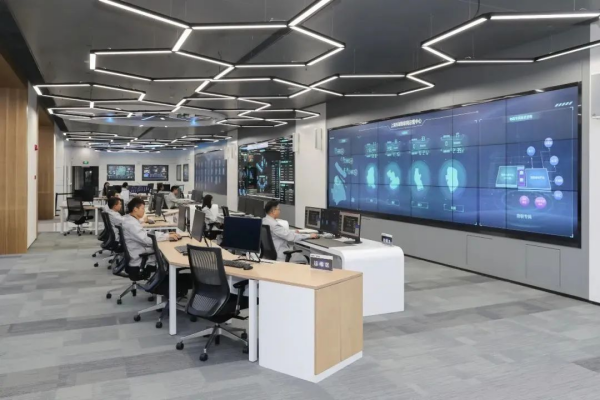At the command center of the Shanghai urban operations management center, real-time data on indicators, such as the total population, traffic conditions, and underpass flooding alerts, are displayed on large screens. This micro-level data collectively forms an invisible digital city, offering insights into the past, present, and future of international metropolitan cities.
This year marks the tenth anniversary of the establishment of the China (Shanghai) Pilot Free Trade Zone. The city has made comprehensive plans to develop the next generation of information infrastructure, and the pilot projects are underway in Jiading District.
In recent years, China Electronics Technology Group Corporation (CETC) and the Shanghai municipal government have been increasing efforts and pioneered new paths for data-driven social governance, urban management, public services, and industrial development.
Dual-center synergy for urban governance
Urban management team members can enforce the law without being physically present, complete tasks like irrigation and fertilization remotely, and accurately predict underpass water at interchange points half an hour ahead of time.
In Jiading district of Shanghai, these have been achieved through a single network and unified management, which are key to highly efficient urban governance.
Aligned with the refined urban governance needs of community governance, and operating on the system focused on IoT, data, and intelligence, CETC has explored an IoT framework in the Jiading urban IoT network pilot project, and a dual-center model connecting the district's urban operations management center with the IoT network operations center, helping Jiading achieve urban governance through one large screen and a single network.

Urban operations data is displayed on a large screen in the command center of the Jiading urban operations management center. [Photo/sasac.gov.cn]
For instance, the system recently identified a case of a shop operating beyond its designated area on a street in Jiading. The device, placed on the street, recognized this unlawful practice and instantly took pictures and generated an alert.
Thanks to the message, swift intervention and processing took place, with the case being filed in the urban management system. The status of this case was simultaneously displayed on the big screen in the command center of the district's urban operations management center.
Behind these quick and efficient responses is the dual-center collaboration model hard at work.
The dual-center collaboration model refers to the dual operations of the city operations management center at the front desk of urban governance and the new urban IoT network operations center at the back. The two operate within the same network, with the former catering to business needs, while the latter offers capabilities for urban intelligent perception. This synergistic relationship forms an efficient operational model of "one-network management".
The CETC's technical experts explain that the dual-center collaboration model improves the efficiency and capacity of perceiving urban events, facilitates professional resources to be directed more effectively toward specialized events, and enhances the public's sense of participation and well-being in urban governance.
Refining urban management through data connectivity
To achieve dual-center collaboration, it is crucial to establish data connectivity among various departments and systems of the city.
After more than three years of efforts, CETC and the Shanghai municipal government have constructed a data system characterized by IoT, data integration, and intelligence. They have launched the first real-time, dynamic, and vivid large-scale urban operations digital system in the country, which empowers urban management by innovation in data, rules, models, and algorithms.
Through the IoT, all types of perception devices related to social governance are connected, linking various departments such as public security, education, and environmental protection. Existing resources are gathered into a unified video sharing platform of the district for sharing and releasing. Currently, over 300 types of social governance sensing devices and more than 100 million pieces of end sensing device data have been accessed, forming the district's multi-level sensing device system.
Data integration refers to integrating data from three major sources, including the IoT, government resources, and public disclosure, securing the data lake of city-level IoT infrastructure. Based on the management requirements from the 16 districts and various administrative bodies of Shanghai, 198 systems, 1,050 Apps, and terabytes of data resources scattered across 55 management entities have been aggregated. This data is stored and shared on urban operations management platforms at all levels, achieving seamless data flow and assisting in one-stop services. Taking Pudong New Area as an example, its data sharing and exchange system has fully quantified the signs of application scenarios and allows them to be incorporated and compiled. Thirty-five most crucial, intuitive, and essential indicators, such as traffic conditions, tourist flow, outpatient and emergency room visits, and water and electricity usage are highlighted to accurately understand the 1,210-square-kilometer urban area.
Through intelligence, event handling rules and industry standards are created to form a knowledge system leveraging the deep learning capacities of artificial intelligence learning platforms. The verified algorithm models are intelligently applied to promote refined and intelligent urban governance through open applications, and to establish a new model for public participation in social governance. For example, Jiading district recently launched six intelligent application scenarios, including the flood prevention of underpasses, monitoring of businesses operating beyond their designated areas, river pollution control, garbage exposure, and fire hazard inspections at small venues. Over 280,000 pieces of information on urban management have been collected, with geographical information about grids, underground pipelines, construction sites, residential communities, and glass curtain walls.
With an eye on the future, CETC is injecting new vitality into the high-quality construction of the China (Shanghai) Pilot Free Trade Zone.
(Executive editor: Xie Yunxiao)